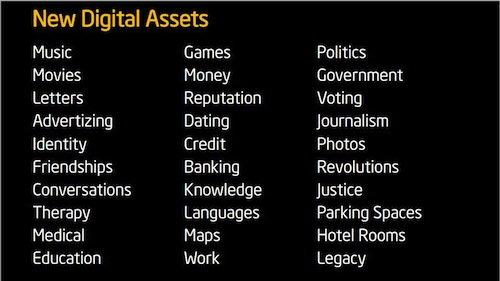What is a digital asset?
As software application development now spans an infinite variety of user touchpoints across a multiplicity of devices, is it fair to assume that our definition of digital assets should also expand?
For a base definition of digital assets, we can say the following:
DIGITAL ASSETS = DATA (in files) + CONTEXT (in the form of metadata)
So as digital assets now start to represent every tangible (often mostly intangible) “thing” that we can assert ownership over, we reach the point where we also want to control and add value to those assets…
… once again, our view of the total digital assets universe is expanding.
There are more “types” of digital assets today and we so we have to broaden our definition of the known universe.
A presentation by Intel futurologists and computing evangelists at the firm’s Intel Developer Forum 2013 presented the following slide with 30 new digital assets.
If we accept this broader universe to be so, then there are direct implications for Digital Asset Management (DAM) and the rest of the computing infrastructure upon which we now base our home and work lives.
If you thought digital assets stopped at files and folders, perhaps it is time to reassess.




